HON HAI PRECISION IND U98Z058 802.11b/g/n WLAN Module User Manual 20100719
HON HAI Precision Ind. Co., Ltd. 802.11b/g/n WLAN Module 20100719
User Manual

COMPANY CONFIDENTIAL
U98Z058.02
USB WiFi Module
User Manual
Rev. 1.0
Prepared by Reviewed by Approved by
Hans Dang Gallon Tao
Index

COMPANY CONFIDENTIAL
1.
REVISION HISTORY...................................................................................................................................................3
2. INTRODUCTION ..........................................................................................................................................................4
3. PRODUCT SPECIFICATION .....................................................................................................................................5
4. PRODUCT REQUIREMENTS AND CHARACTERISTIC......................................................................................7
5. ANTENNA SPECIFICATION .....................................................................................................................................9
6. MECHANICAL DRAWING .......................................................................................................................................14
7. SCHEMATIC ...............................................................................................................................................................14
8. BOM LIST....................................................................................................................................................................16
9. PCB LAYOUT.............................................................................................................................................................17
10. PACKING ..................................................................................................................................................................22
11. REGULATORY.........................................................................................................................................................26
12. ENVIRONMENTAL REQUIREMENTS AND SPECIFICATIONS.....................................................................26
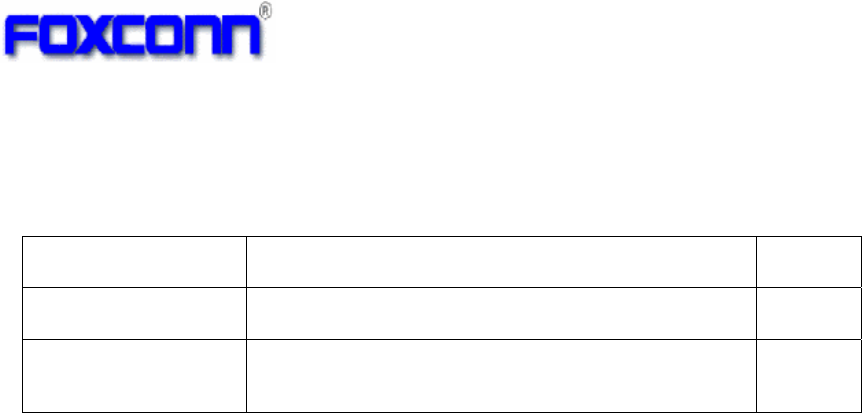
COMPANY CONFIDENTIAL
1. Revision History
Date Change Note REV
Note
2010-06-17 Initial Release 1.0

COMPANY CONFIDENTIAL
2. Introduction
Project Name: 802.11 b/g/n wireless card
This documentation describes the product specification of the 802.11b/g/n WiFi Module.
It is Compliant with IEEE Std 802.11b-1999, IEEE Std 802.11g-2003 and IEEE Std
802.11n-2009. It is a confidential document of Foxconn.
2.1 Scope
This 802.11 b/g/n Module is available in the 2.4-GHz ISM band, it is compatible with
the IEEE 802.11 b/g standard and the 802.11n standard. It allow user to switch to
different vendors’ Access Points through the wireless networks and to prevent from
eavesdropping. The 802.11 g data rate provides for 54, 48, 36, 24, 18, 12, 9, 6Mbps,
802.11b data rate provides for 11, 5.5, 2, 1 Mbps, it can also support 11n high data
rate up to MCS7 with PHY data rate to 135Mbps.
2.2 Function
¾ Single stream 802.11 support for both 20MHz and 40MHz (optional) channels provide
PHY layer rates up to MCS7(150Mbps).
¾ Support IEEE 802.15.2 external 3-wire additional co-located wireless technologies
such as Bluetooth, GPS, WiMax or UWB.
¾ Provides a small form factor solution and ultra low power consumption to support low
cost requirement.
¾ Host interface supports USB, SDIO is not used in this product.
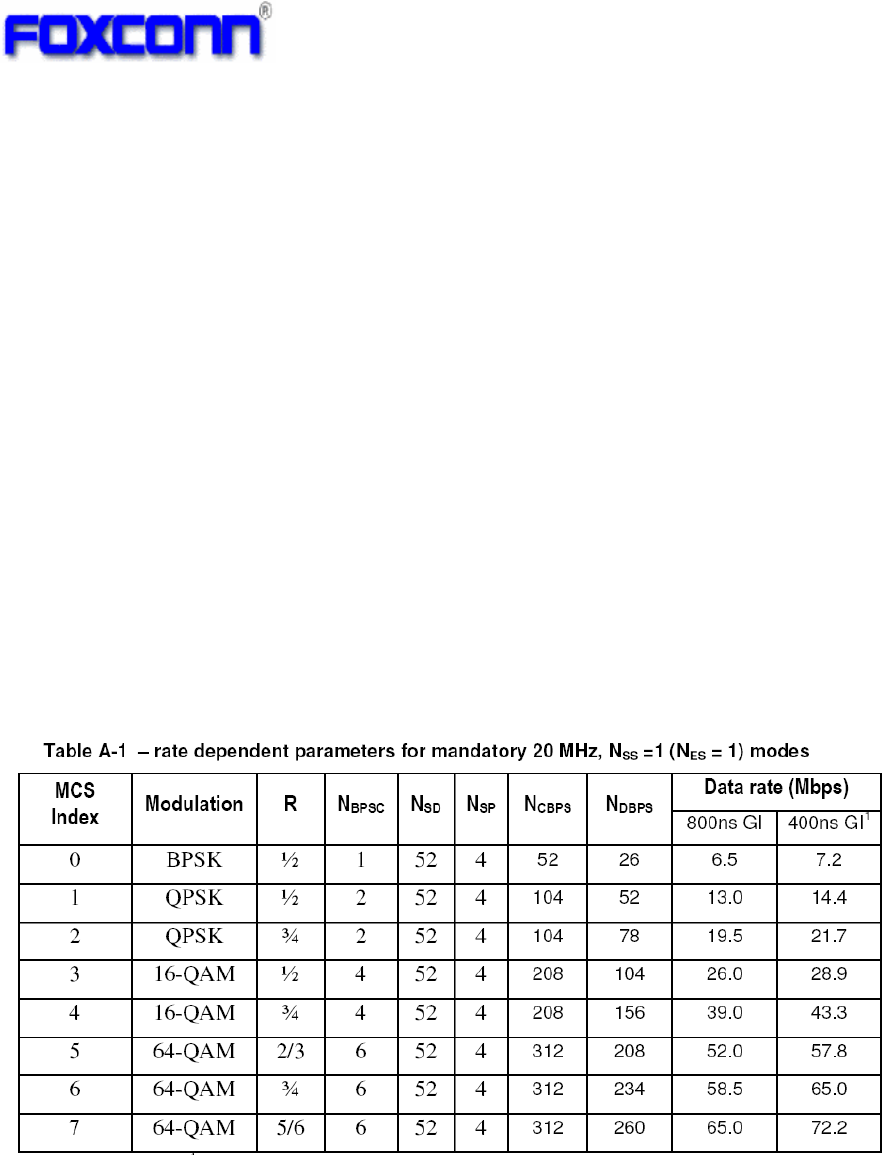
COMPANY CONFIDENTIAL
3. Product Specification
3.1 WiFi RF Specification
Wireless LAN Standards IEEE 802.11 b/g/n standard
Operating Frequency 2.400 – 2.4835 GHz
WLAN Data Rate 802.11g: 54Mbps with fall back of 48, 36, 24, 18,
12, 9, 6Mbps.
802.11b: 11Mbps with fall back rates of 5.5, 2,
and 1Mbps
802.11n: Data Rate (MCS0~MSC7) refer to Table
A-1 and Table A-2
Modulation Schemes 802.11g:
64QAM (54Mbps, 48Mbps), 16QAM (36Mbps,
24Mbps), QPSK (18Mbps, 12Mbps), BPSK
(9Mbps, 6Mbps)
802.11b: CCK (11 Mbps, 5.5Mbps), DQPSK (2
Mbps), DBPSK (1 Mbps)
802.11n: refer to Table A-1 and Table A-2
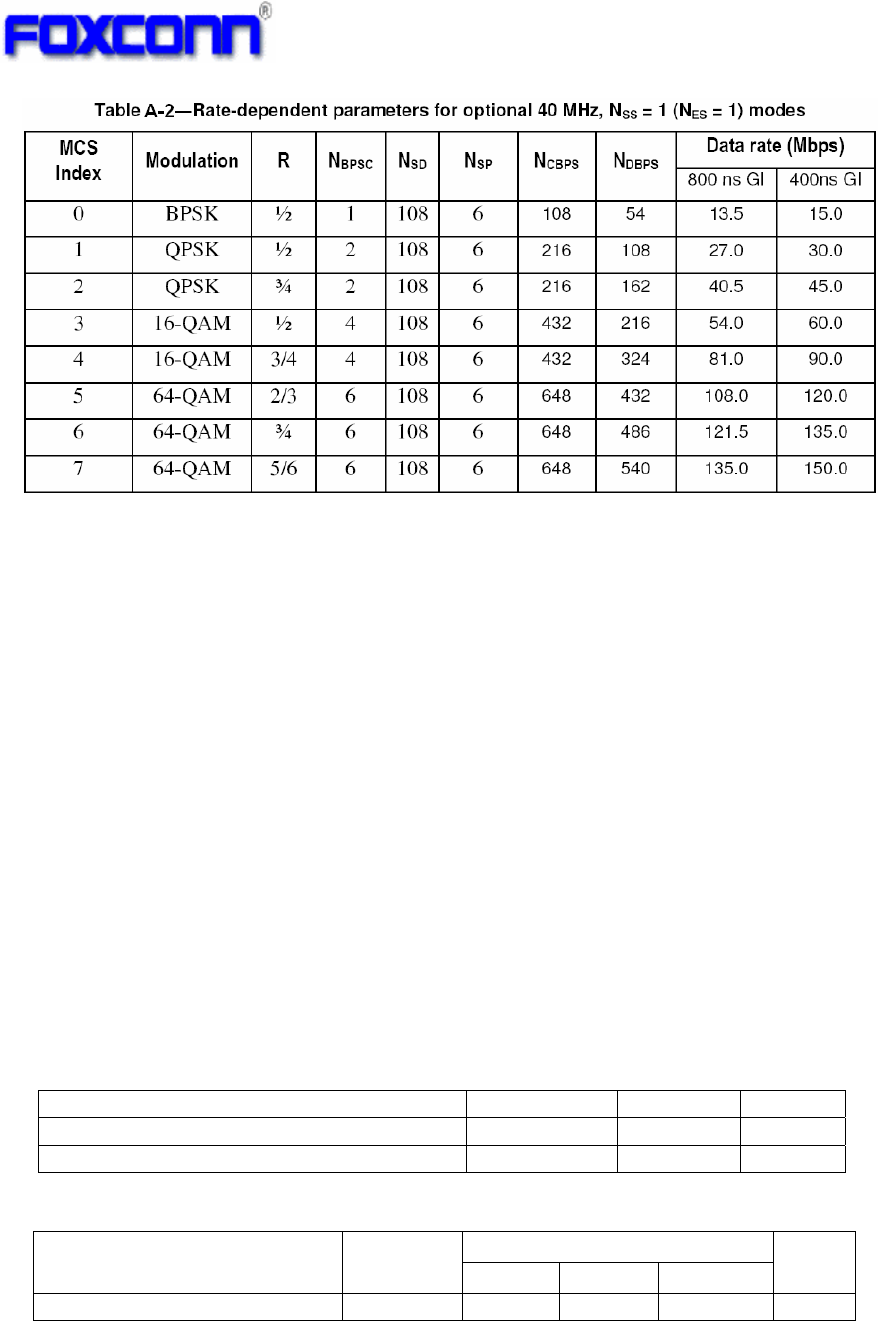
COMPANY CONFIDENTIAL
*
40MHz bandwidth is optional for transmit and receive.
Transmitter AV Output Power
11b CCK: 17.5+/-1.5 dBm
11g OFDM: 14.0 +1/-2 dBm
11n MCS0~MCS7: 14.0 +1/-2 dBm
Receiver Sensitivity
Typical -87dBm @11Mbps (PER<8%)
Typical -75dBm @54Mbps (PER<10%)
Typical -70dBm @MCS7 (PER<10%)
3.2 Electrical Specification
Absolute Maximum Ratings
These specification indicate levels where permanent damage to the device can occur. Functional
operation is not guaranteed under these conditions. Operation at absolute maximum conditions for
extended can adversely affect long-term reliability of the device.
Recommended Operating Condition
Value Element Symbol
Minimum Typical Maximum
Unit
DC supply voltage for the device VDD_USB 3.0 3.3 3.63 V
Function operation is not guaranteed outside this limit, and operation outside this limit for extended
periods can adversely affect long-term reliability of the device.
Rating Symbol Value Unit
DC supply voltage for the device VDD_USB -0.5 to +4.1 V
Maximum chip junction temperature Tj 125 ºC
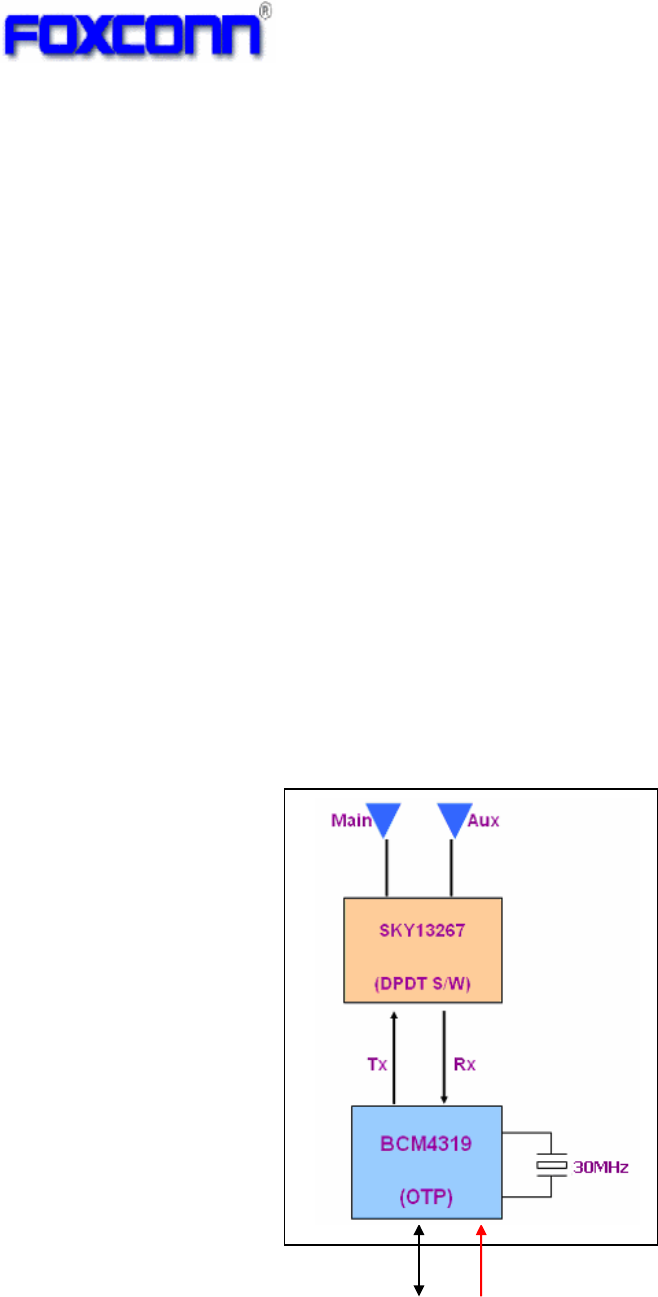
COMPANY CONFIDENTIAL
Current Consumption
Standby: typically 120mA @3.3V
Transmit:
802.11b: typically 320mA @3.3V (Tx Power=17.5dbm)
802.11g: typically 310mA@3.3V (Tx Power=14dbm)
802.11n: typically 315mA@3.3V (Tx Power=14dbm)
Receive: typically 220mA @3.3V
4. Product Requirements and Characteristic
4.1 Hardware Characteristic
Form factor 44.5x40(mm
2
) module with 2x4 pin connector
Host Interface USB 2.0
PCB 4-layer single side
Antenna &RF connector Two printed Antenna, with one for diversity.
One U.FL switched RF connector for testing and can be also used
for external antenna
4.2 Hardware Architecture
This 802.11b/g/n device is operating at 2.4 GHz ISM band, it supports 20 MHz and 40 MHz
(optional) channels.
The WiFi design is based on Broadcom BCM4319 chipset.
The Broadcom BCM4319 is a highly integrated single chip solution for 2.4GHz 802.11n-ready wireless
local area network that enables a high performance 1X1 configuration for wireless station maximum
throughput and range, it integrated a multi-protocol MAC, baseband processor, ADC and DAC
converters, 1X1 radio transceiver, RF switch in all-CMOS device.
Figure 1 Functional Block Diagram
USB I/F 3.3V
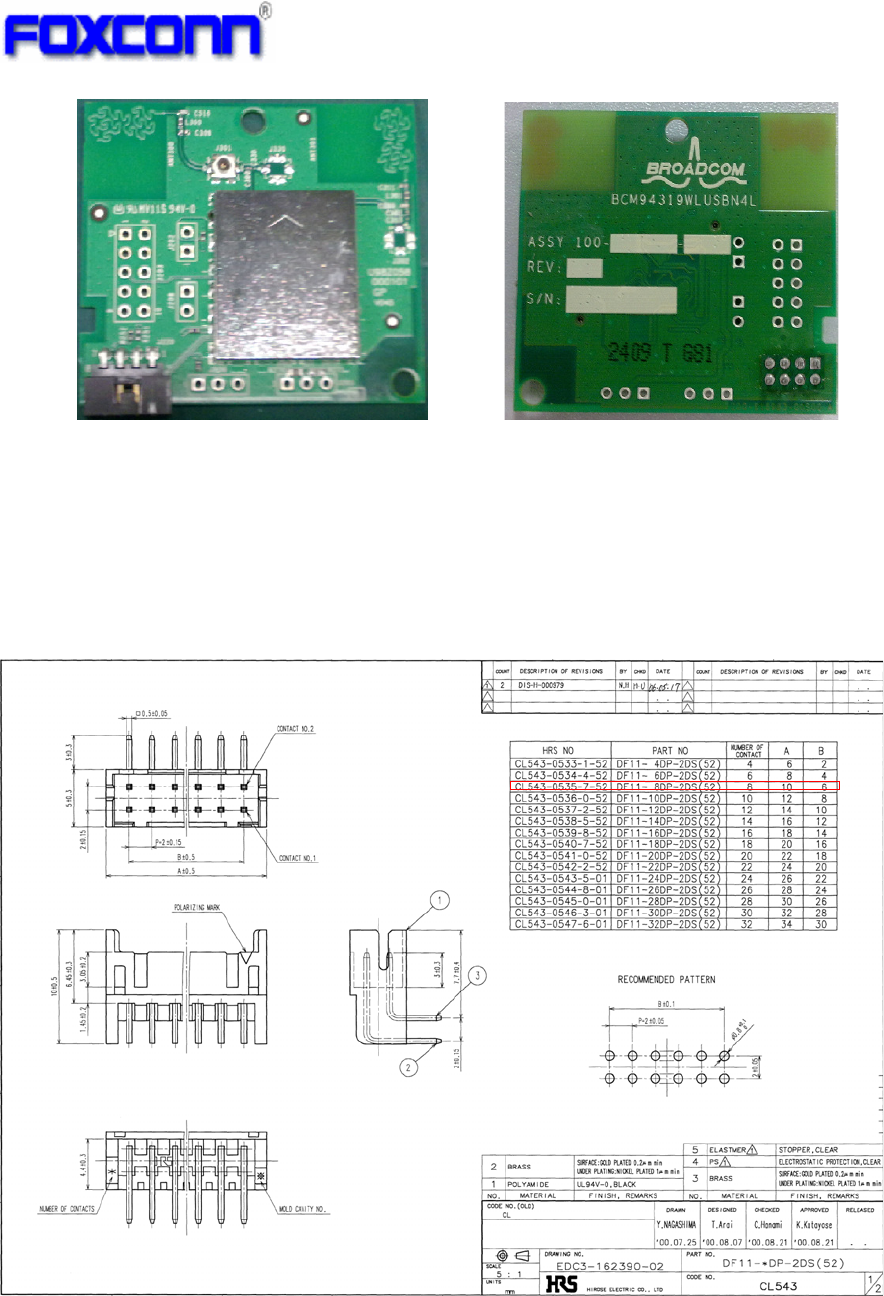
COMPANY CONFIDENTIAL
Top Bottom
Figure 2 Board Appearance (For reference)
4.3. Connector information
Connector: 2x4P, T/H, Male, Right Angle, 2mm pin pitch.
Hirose P/N: DF11-8DP-2DS (52)
4.4 Connector Pin Assignment
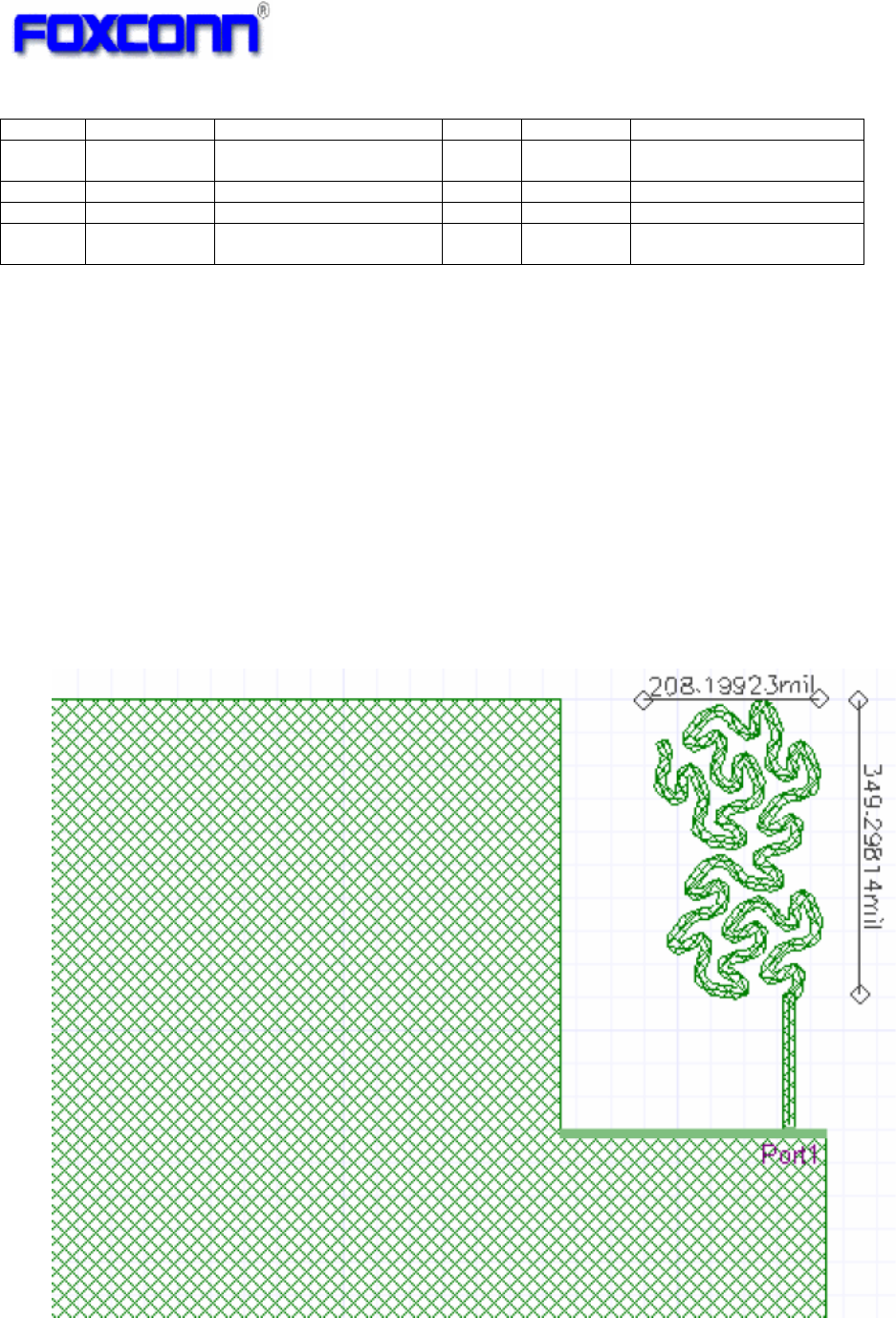
COMPANY CONFIDENTIAL
Pin No. Pin Name Description Pin No. Pin Name Description
1 VDD_USB Power supply for the
device, 3.3 typically.
2 VDD_USB Power supply for the
device, 3.3 typically.
3 GND Ground 4 GND Ground
5 USB_DP USB differential positive 6 USB_DM USB differential negative
7 WL_REG_ON Enable/disable power the
internal regulators
8 GND Ground
Notice:
WL_REG_ON is used by PMU to enable/disable power the internal regulators, ViH=1.6V, maximum=3.6V.
When WL_REG_ON is low (<1.2(1-20%)=0.96V) or the voltage at VDDIO is less than 0.96V, all six internal
regulators are powered down.
When WL_REG_ON is high (>1.6V) and the voltage at VDDIO is greater than 1. 6V, the CBUCK, LDO2p5V,
CLDO, and LNLDO1 regulators are powered on default.
The voltage at WL_REG_ON should not exceed 3.6V.
There’s a 200Kȍ internal pull-down on WL_REG_ON.
In normal operation mode, WL_REG_ON is pulled-high to 3.3V; and when the device is not needed in the
system, WL_REG_ON should be driven low while VDDIO remains powered, which is called Low-Power
shutdown mode.
5. Antenna Specification
The antennas are PCB printed antenna, its pattern show as below.
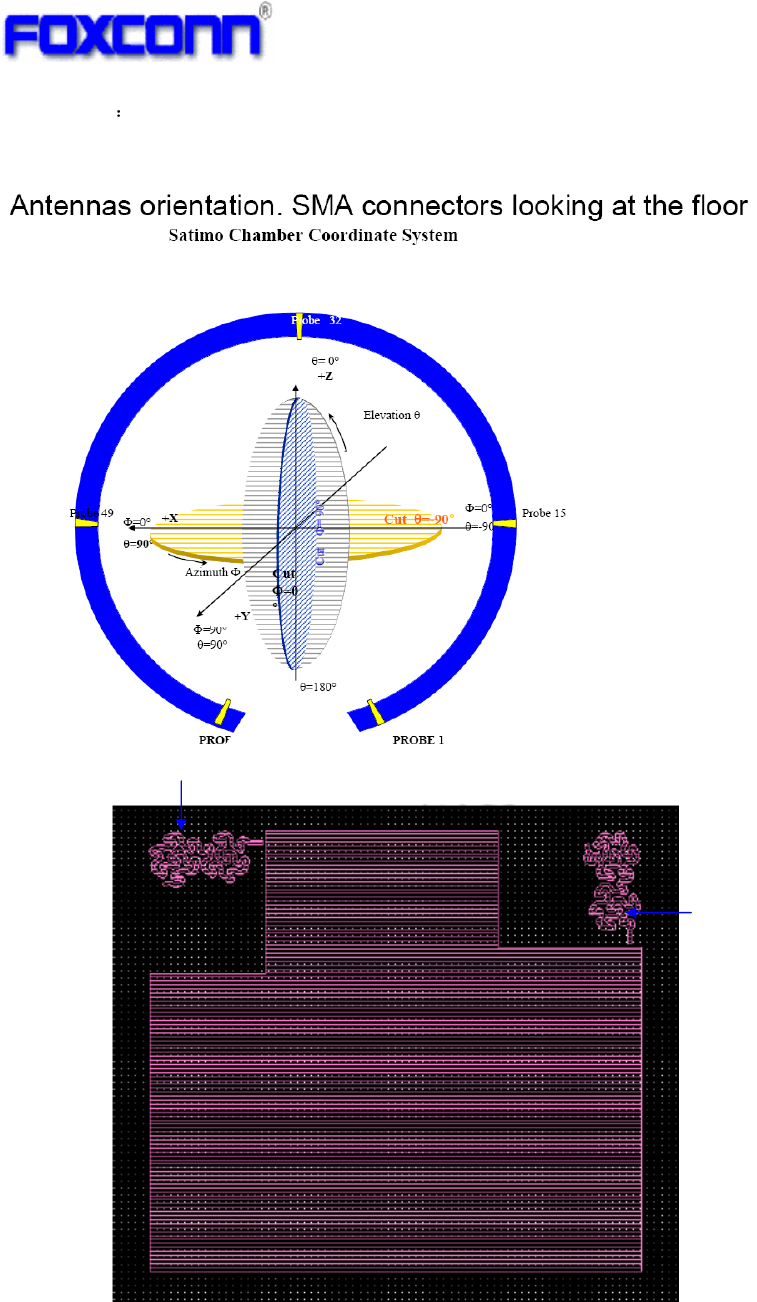
COMPANY CONFIDENTIAL
Features
2.4 to 2.5 GHz operation
VSWR better than 2:1
Efficiency >72%
Ant A
Ant B
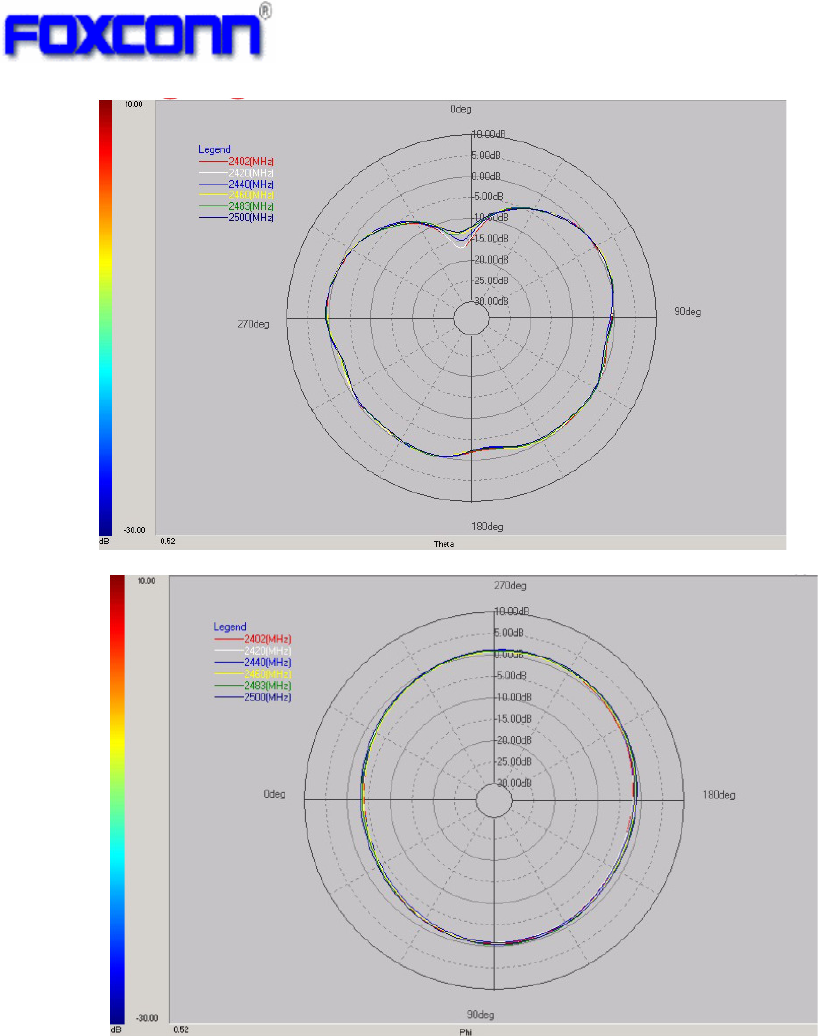
COMPANY CONFIDENTIAL
Phi 0 plane cut ant A
Phi 90 plane cut ant A
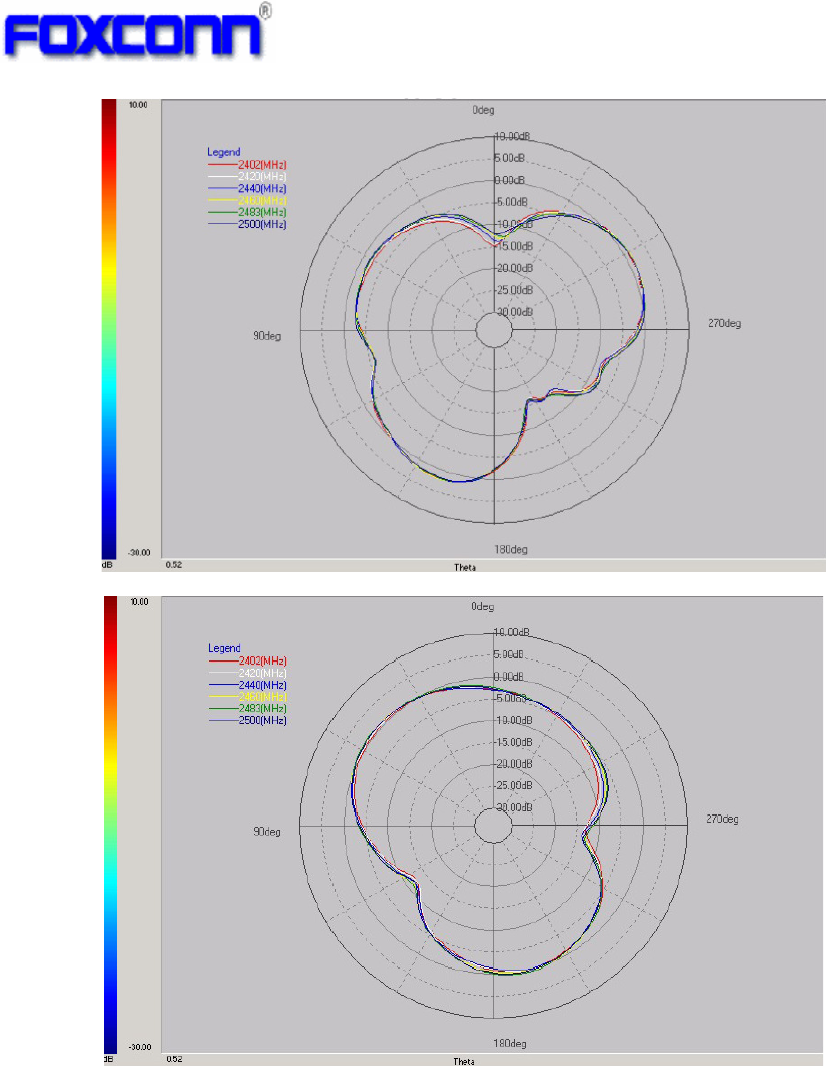
COMPANY CONFIDENTIAL
Theta 90 plane cut ant A
Phi 0 plane cut ant B
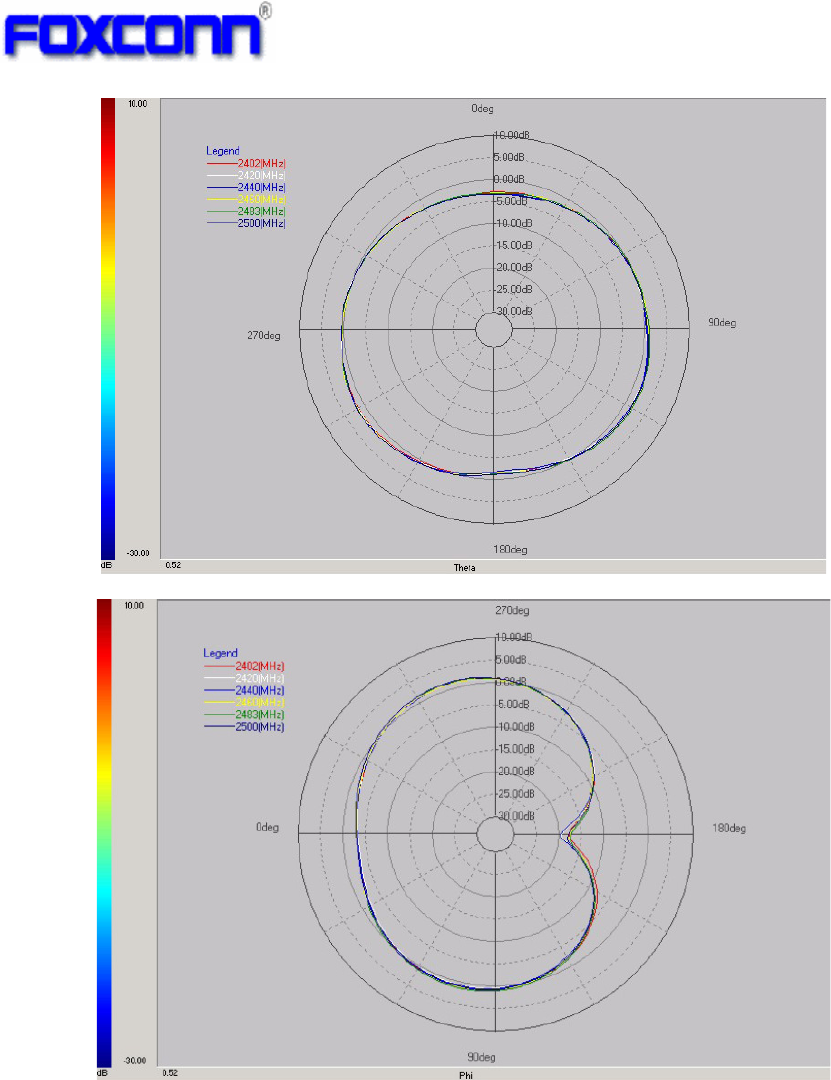
COMPANY CONFIDENTIAL
Phi 90 plane cut ant B
Theta 90 plane cut ant B
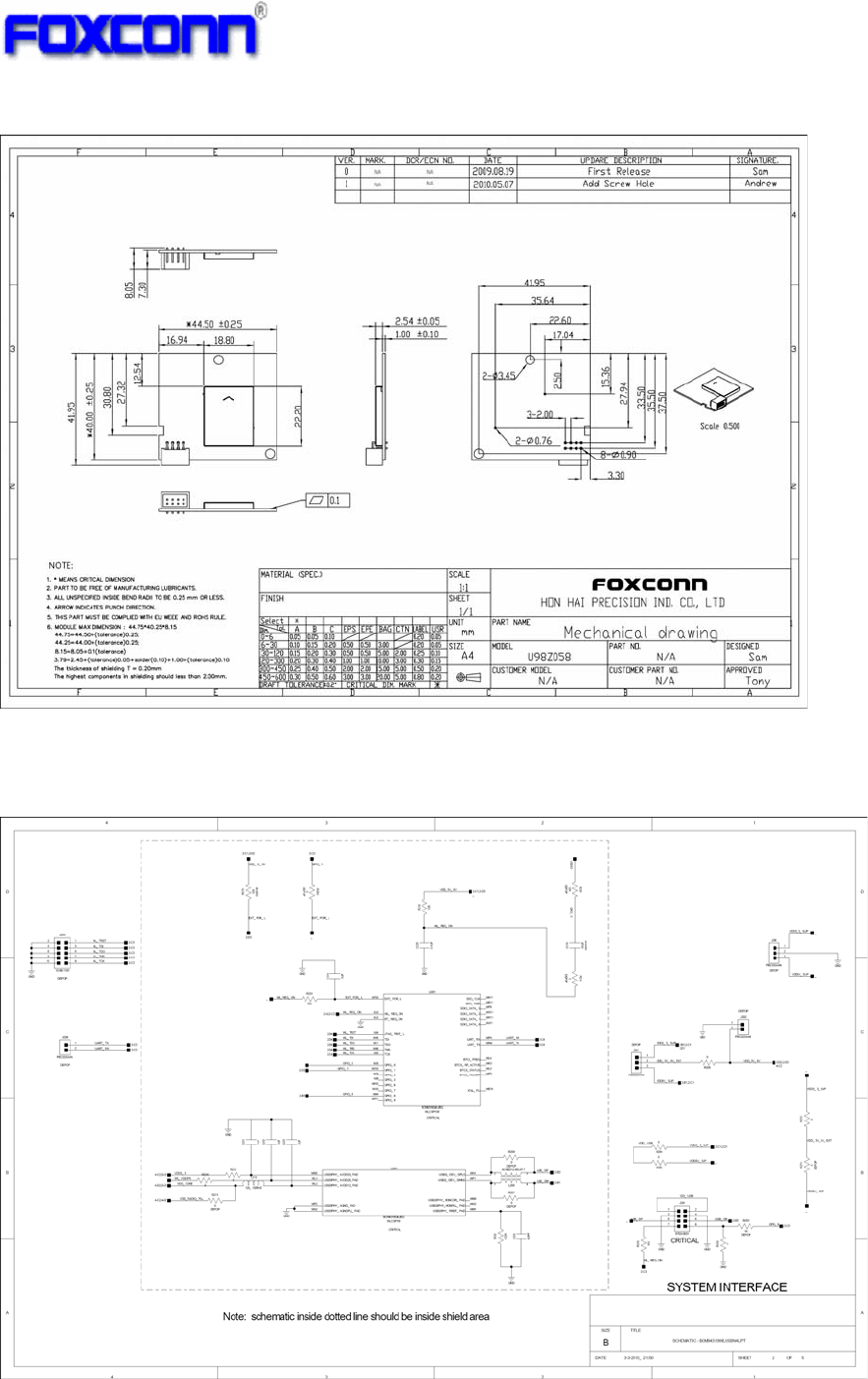
COMPANY CONFIDENTIAL
6. Mechanical Drawing
7. Schematic
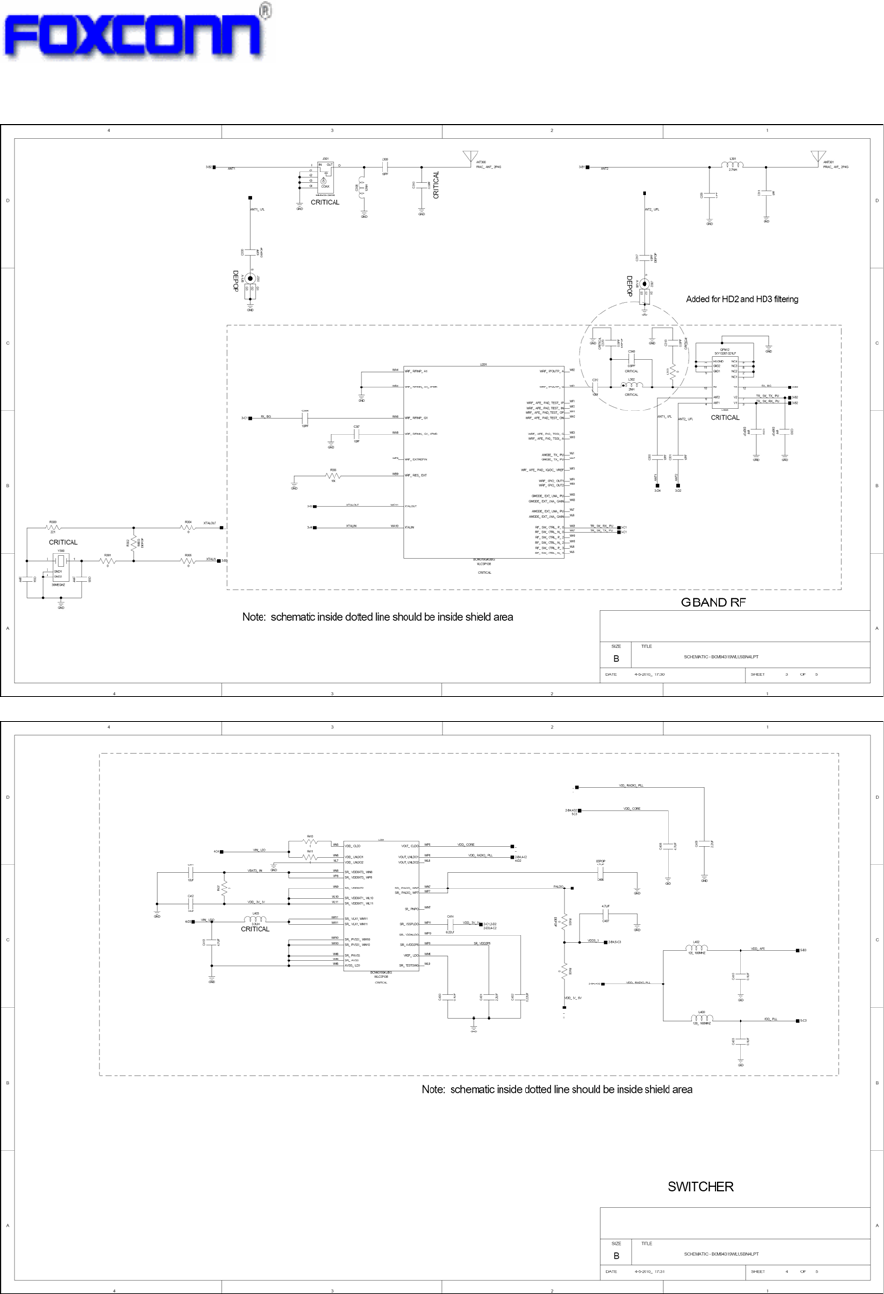
COMPANY CONFIDENTIAL
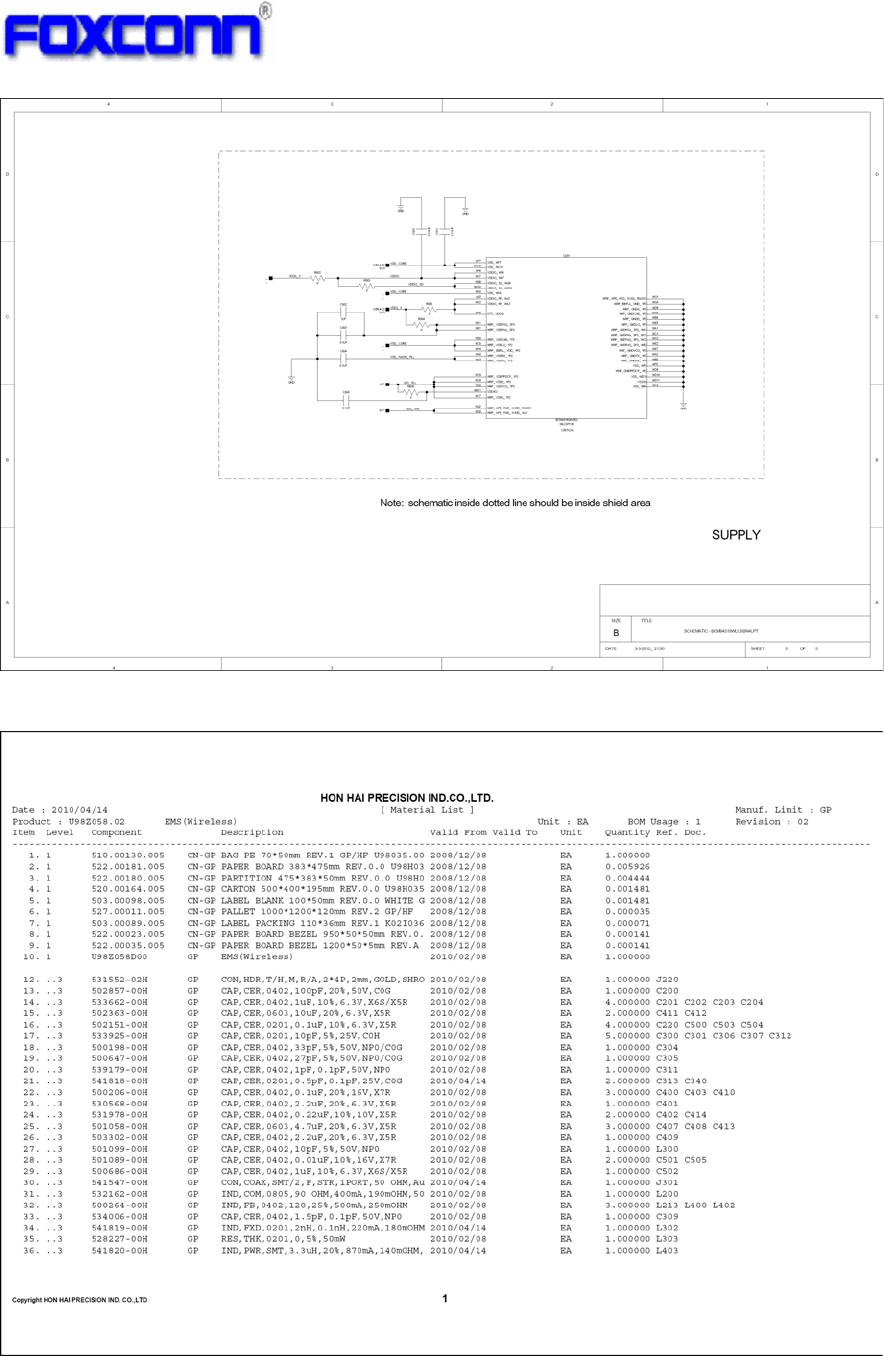
COMPANY CONFIDENTIAL
8. BOM List
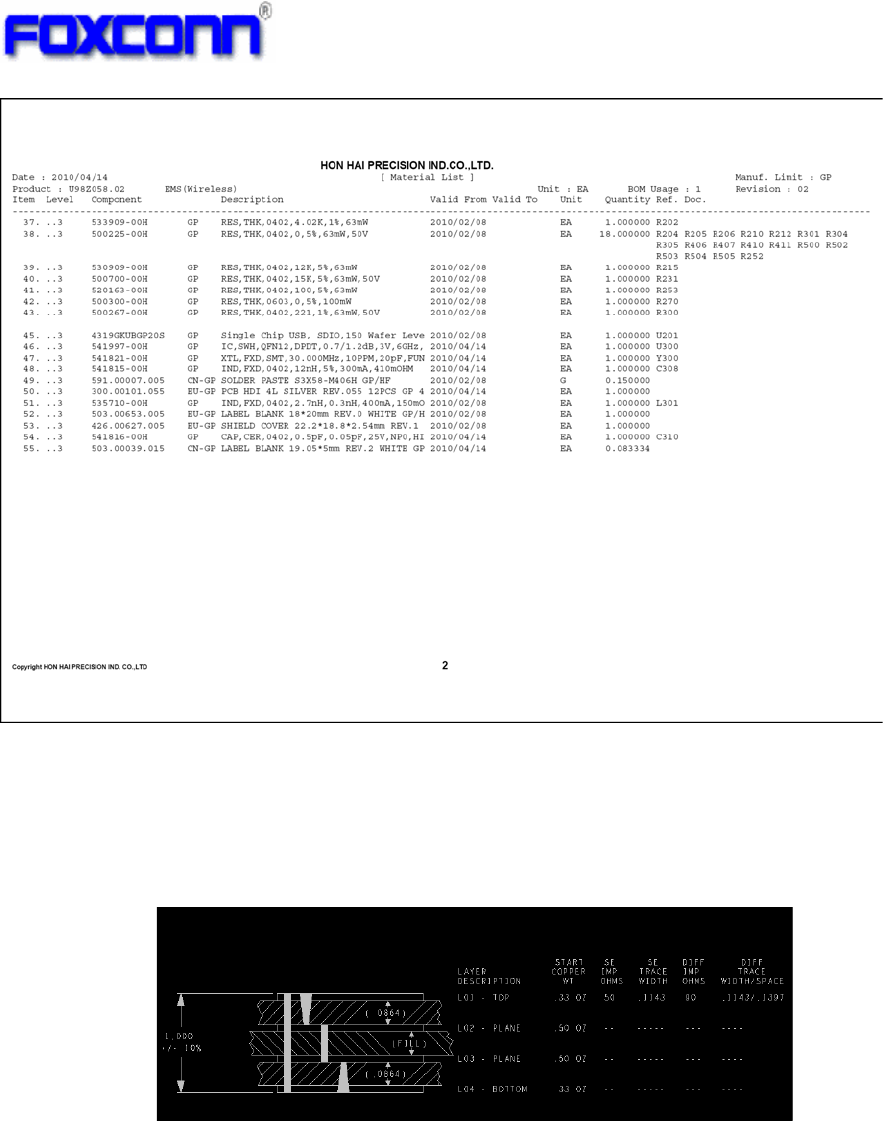
COMPANY CONFIDENTIAL
9. PCB Layout
U98Z058.02 PCB is a 4-layer, HDI design, its surface finish is Immersion Silver.
Stack-up
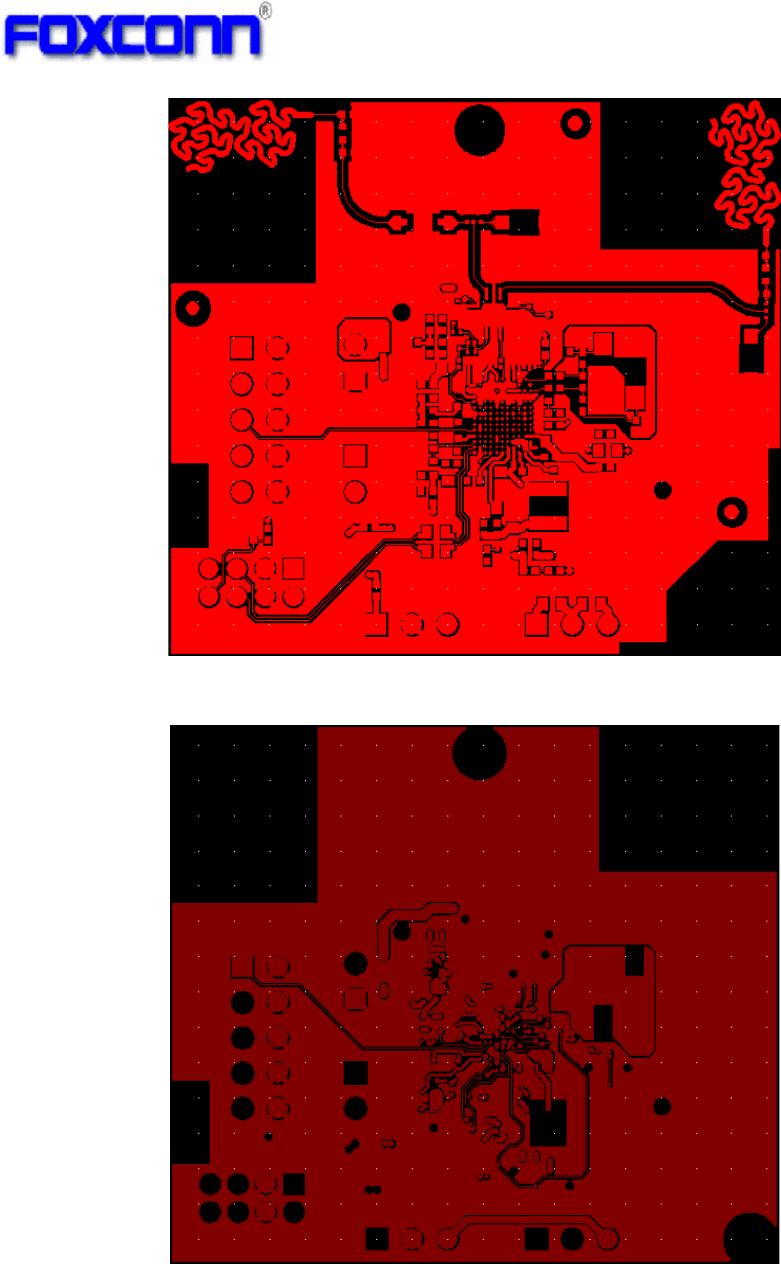
COMPANY CONFIDENTIAL
Top Layer
Layer 2
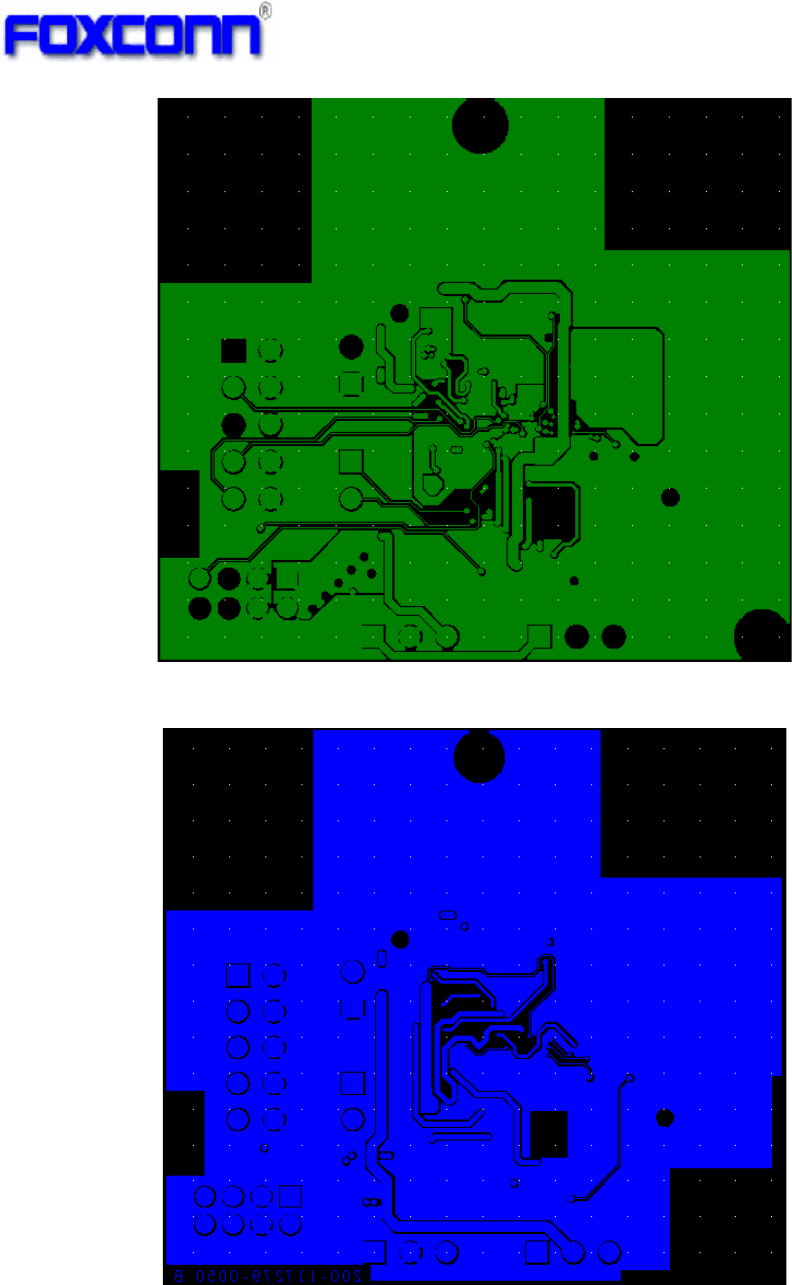
COMPANY CONFIDENTIAL
Layer 3
Bottom Layer
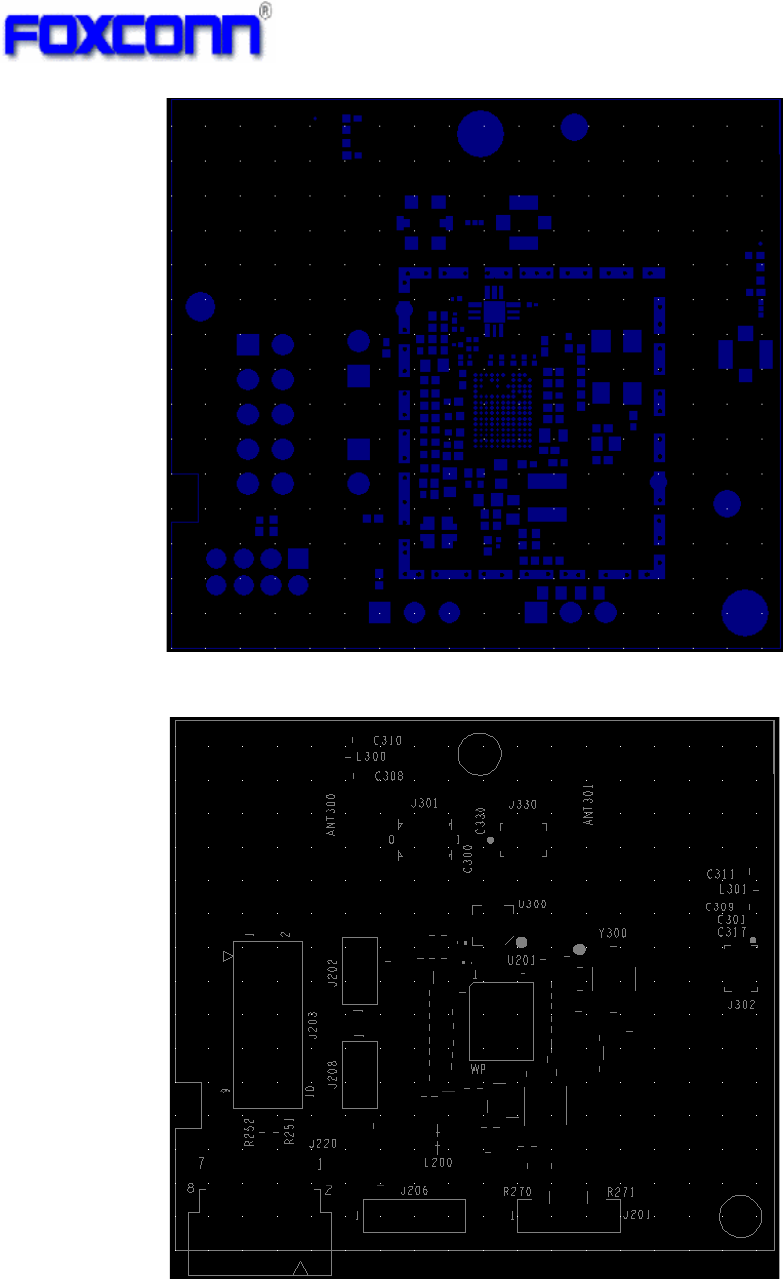
COMPANY CONFIDENTIAL
Top Side Solder Mask
Top Side Silk Screen
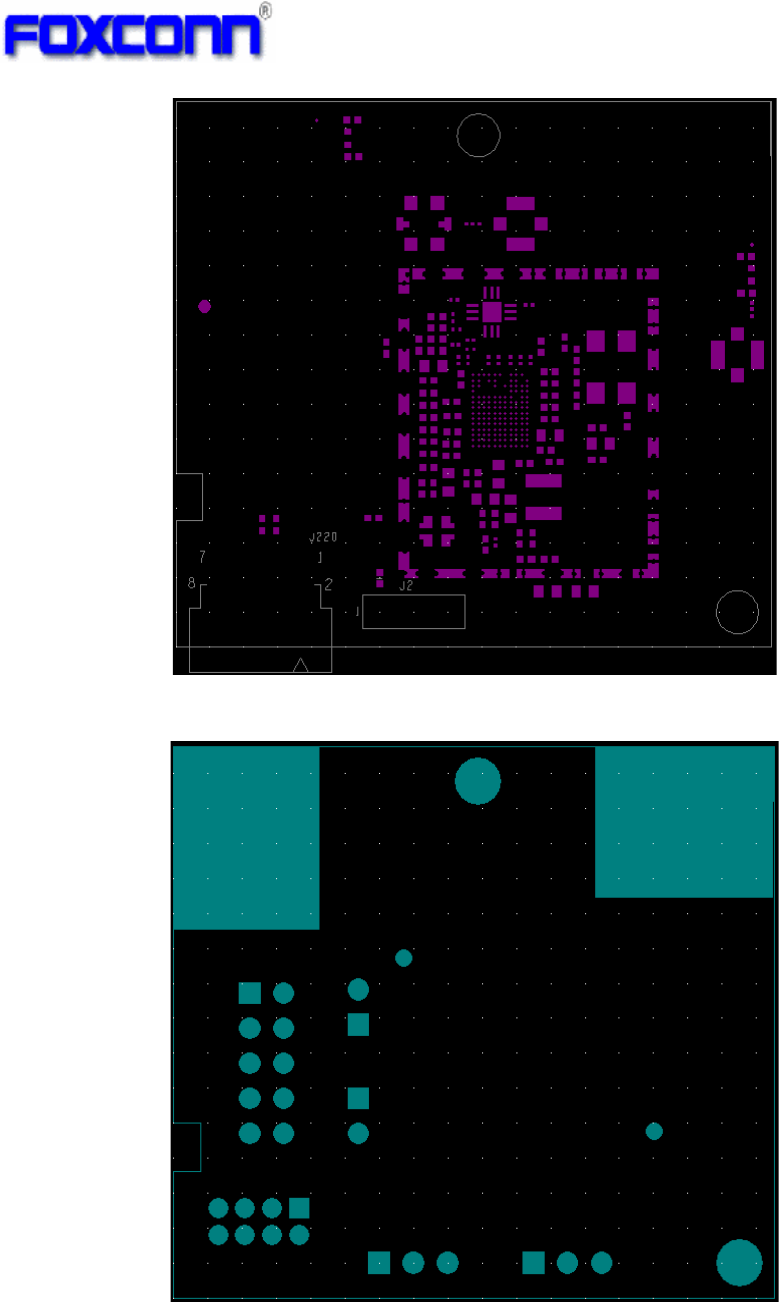
COMPANY CONFIDENTIAL
Top Side Paste Mask
Bottom Side Solder Mask
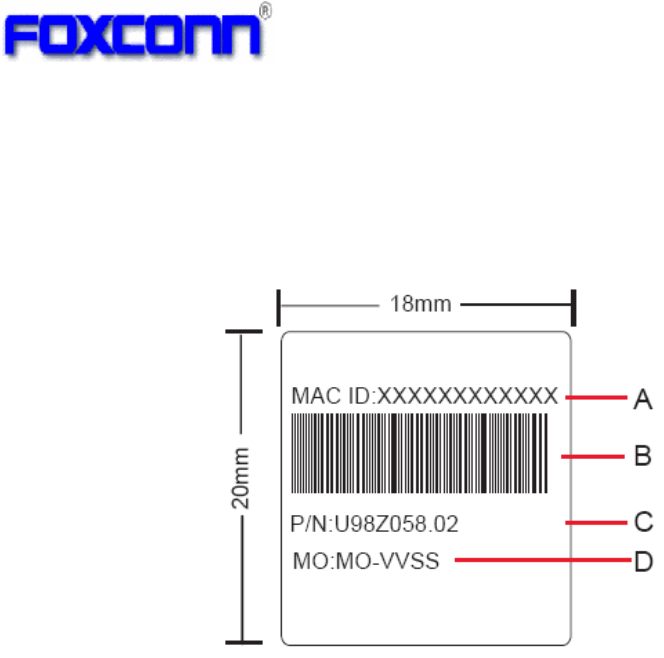
COMPANY CONFIDENTIAL
10. Packing
10.1 Label
10.1.1. MAC ID label: P/N:503.00653.005……1 MAC ID/product
Human readable:
A.MAC ID:XXXXXXXXXXXX
MAC ID Barcode, follow Foxconn standard.
C.P/N:U98Z058.02
D.MO: MO-VVSS
a. First MO: is letter
b. Second MO is Foxconn MO, follow Foxconn standard
c. VV: The engineering version
d. SS: The version of A300/A400 product
Barcode content:
XXXXXXXXXXXX
MAC ID Barcode, follow Foxconn standard
Barcode type: code39, height: 4mm
10.1.2. Carton label: P/N:503.00098.005
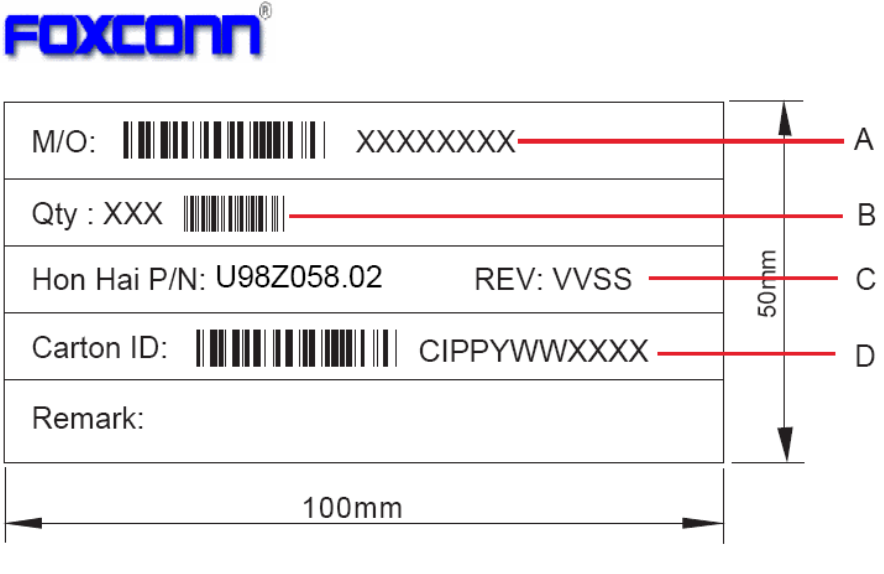
COMPANY CONFIDENTIAL
A.XXXXXXXX: the Foxconn MO
B. Qty: XXX
XX: The quantity of product in carton
Barcode content: The quantity of product in carton
C.REV: VVSS
VV: The engineering version
SS: The version of A300/A400
D.CIPPYWWXXXX
Carton ID Text Definition:
C - Carton
l - Production Location Code
PP - Production Line Identity
Y-year code: 2010 AD
WW - The products are built in the 14th week
XXXX - The four decade serial numbers
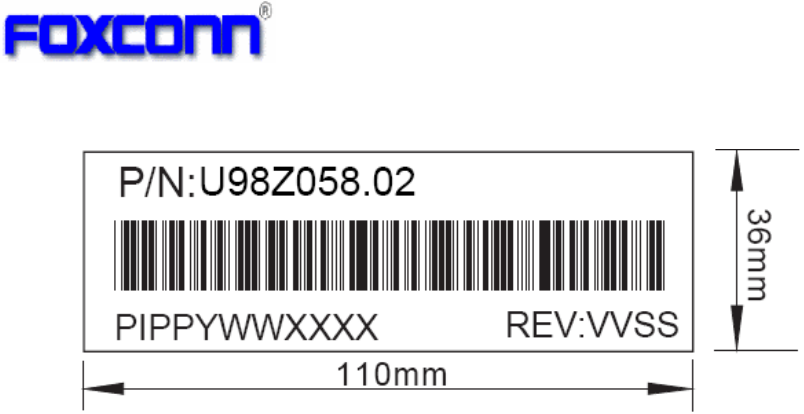
COMPANY CONFIDENTIAL
10.1.3 Pallet label: P/N:503.00089.005
Pallet ID Text Definition˖
PIPPYWWXXXX
P - Pallet
l - Production Location Code
PP - Production Line Identity
Y-year code: 2010 AD
WW - The products are built in the 14th week
XXXX - The four decade serial numbers

COMPANY CONFIDENTIAL
10.2 Assembly Drawing & Packing Standard
Federal Communication Commission Interference Statement
This equipment has been tested and found to comply with the limits for a Class B digital device, pursuant to Part 15
of the FCC Rules. These limits are designed to provide reasonable protection against harmful interference in a
residential installation. This equipment generates, uses and can radiate radio frequency energy and, if not installed
and used in accordance with the instructions, may cause harmful interference to radio communications. However,
there is no guarantee that interference will not occur in a particular installation. If this equipment does cause harmful
interference to radio or television reception, which can be determined by turning the equipment off and on, the user is
encouraged to try to correct the interference by one of the following measures:
- Reorient or relocate the receiving antenna.
- Increase the separation between the equipment and receiver.
- Connect the equipment into an outlet on a circuit different from that
to which the receiver is connected.
- Consult the dealer or an experienced radio/TV technician for help.
This device complies with Part 15 of the FCC Rules. Operation is subject to the following two conditions: (1) This
device may not cause harmful interference, and (2) this device must accept any interference received, including
interference that may cause undesired operation.
FCC Caution: Any changes or modifications not expressly approved by the party responsible for compliance could
void the user's authority to operate this equipment.
IMPORTANT NOTE:
FCC Radiation Exposure Statement:
This equipment complies with FCC radiation exposure limits set forth for an uncontrolled environment. This
equipment should be installed and operated with minimum distance 20cm between the radiator & your body.
This transmitter must not be co-located or operating in conjunction with any other antenna or transmitter.
IEEE 802.11b or 802.11g operation of this product in the U.S.A. is firmware-limited to channels 1 through 11.
This device is intended only for OEM integrators under the following conditions:
1) The antenna must be installed such that 20 cm is maintained between the antenna and users, and
2) The transmitter module may not be co-located with any other transmitter or antenna,
3) For all products market in US, OEM has to limit the operation channels in CH1 to CH11 for 2.4G band by supplied
firmware programming tool. OEM shall not supply any tool or info to the end-user regarding to Regulatory Domain
change.
A
s long as 3 conditions above are met, further transmitter test will not be required. However, the OEM integrator is
still responsible for testing their end-product for any additional compliance requirements required with this module
installed (for example, digital device emissions, PC peripheral requirements, etc.).
IMPORTANT NOTE: In the event that these conditions can not be met (for example certain laptop configurations or
co-location with another transmitter), then the FCC authorization is no longer considered valid and the FCC ID can
not be used on the final product. In these circumstances, the OEM integrator will be responsible for re-evaluating the
end product (including the transmitter) and obtaining a separate FCC authorization.
End Product Labeling
This transmitter module is authorized only for use in device where the antenna may be installed such that 20 cm may
be maintained between the antenna and users. The final end product must be labeled in a visible area with the
following: “Contains FCC ID: MCLU98Z058”.
Manual Information To the End User
The OEM integrator has to be aware not to provide information to the end user regarding how to install or remove
this RF module in the user's manual of the end product which integrates this module.
The end user manual shall include all required regulatory information/warning as show in this manual.
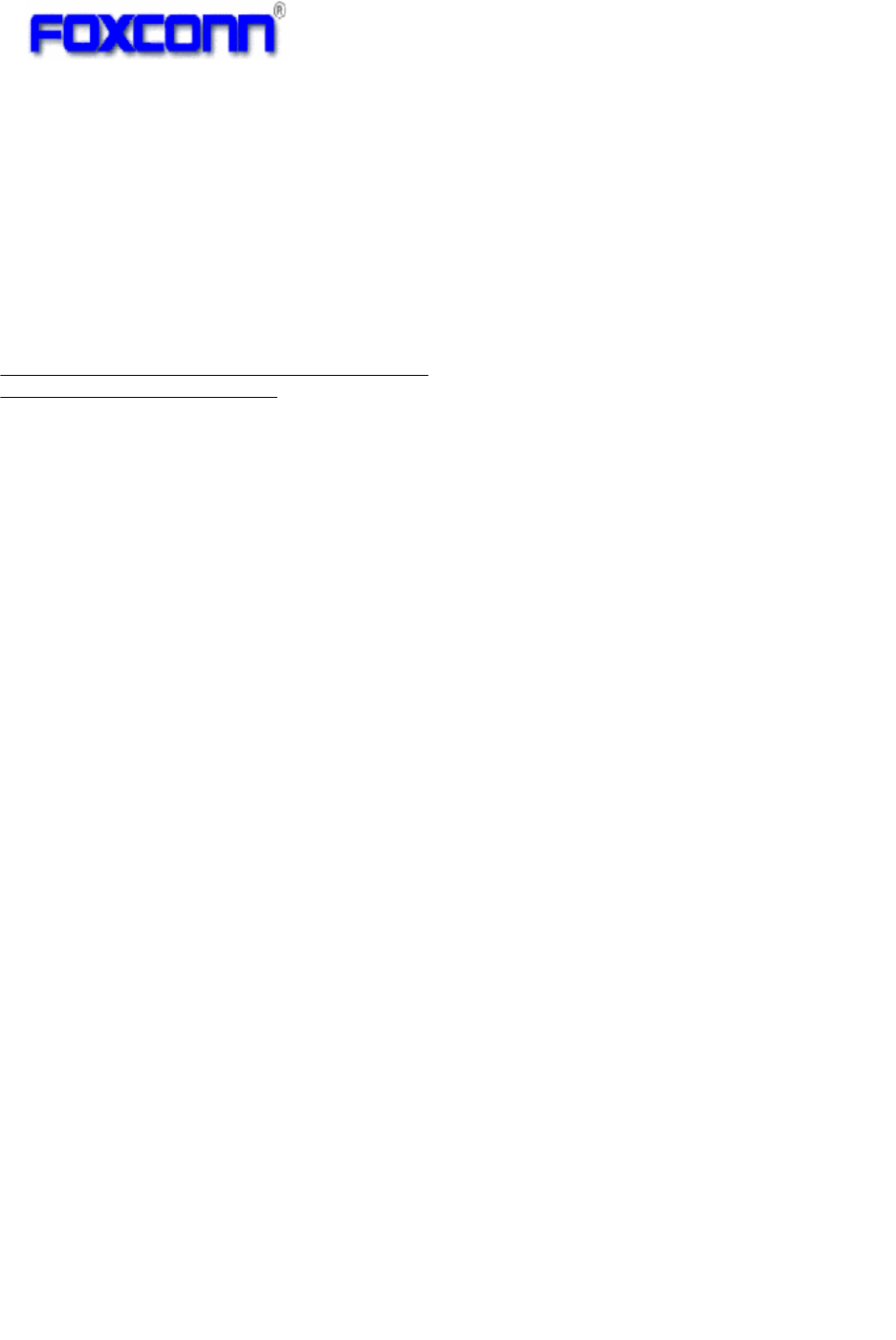
COMPANY CONFIDENTIAL
11. Regulatory
TBD
12. Environmental Requirements and Specifications
12.1 Temperature
12.1.1 Operating Temperature Conditions
The product shall be capable of continuous reliable operation when
operating in ambient temperature of 0 to +ć70 .ć
12.1.2 Non-Operating Temperature Conditions
Neither subassemblies shall be damaged nor shall the operational
performance be degraded when restored to the operating temperature when
exposed to storage temperature in the range of -10 to +ć85ć
.
12.2 Humidity
12.2.1 Operating Humidity Conditions
The product shall be capable of continuous reliable operation when
Industry Canada Statement
This device complies with RSS-210 of the Industry Canada Rules. Operation is subject to the following two
conditions:
1) this device may not cause interference and
2) this device must accept any interference, including interference that may cause undesired operation of the
device
IMPORTANT NOTE:
IC Radiation Exposure Statement:
This equipment complies with IC radiation exposure limits set forth for an uncontrolled environment. This
equipment should be installed and operated with minimum distance 20cm between the radiator & your body.
This device is intended only for OEM integrators
under the following conditions:
2/!The antenna must be installed such that 20 cm is maintained between the antenna and users, and
3/!The transmitter module may not be co-located with any other transmitter or antenna,
4/!For all products market in CANADA, OEM has to limit the operation channels in CH1 to CH11 for 2.4GHz
band by supplied firmware programming tool. OEM shall not supply any tool or info to the end-user regarding
to Regulatory Domain change.
A
s long as 3 conditions above are met, further transmitter test will not be required. However, the OEM
integrator is still responsible for testing their end-product for any additional compliance requirements required
with this module installed (for example, digital device emissions, PC peripheral requirements, etc.).
IMPORTANT NOTE: In the event that these conditions can not be met (for example certain laptop
configurations or co-location with another transmitter), then the IC authorization is no longer considered valid
and the IC ID can not be used on the final product. In these circumstances, the OEM integrator will be
responsible for re-evaluating the end product (including the transmitter) and obtaining a separate IC
authorization.
End Product Labeling
The final end product must be labeled in a visible area with the following: “Contains TX IC : 2878D-
U98Z058”.
Manual Information That Must be Included
The OEM integrator has to be aware not to provide information to the end user regarding how to install o
r
remove this RF module in the user's manual of the end product which integrates this module.
The end user manual shall include all required regulatory information/warning as show in this manual.

COMPANY CONFIDENTIAL
subjected to relative humidity in the range of 10% and 90% non-condensing.
12.2.2 Non-Operating Humidity conditions
The product shall not be damaged nor shall the performance be degraded
after exposure to relative humidity ranging from 5% to 95% non-condensing.